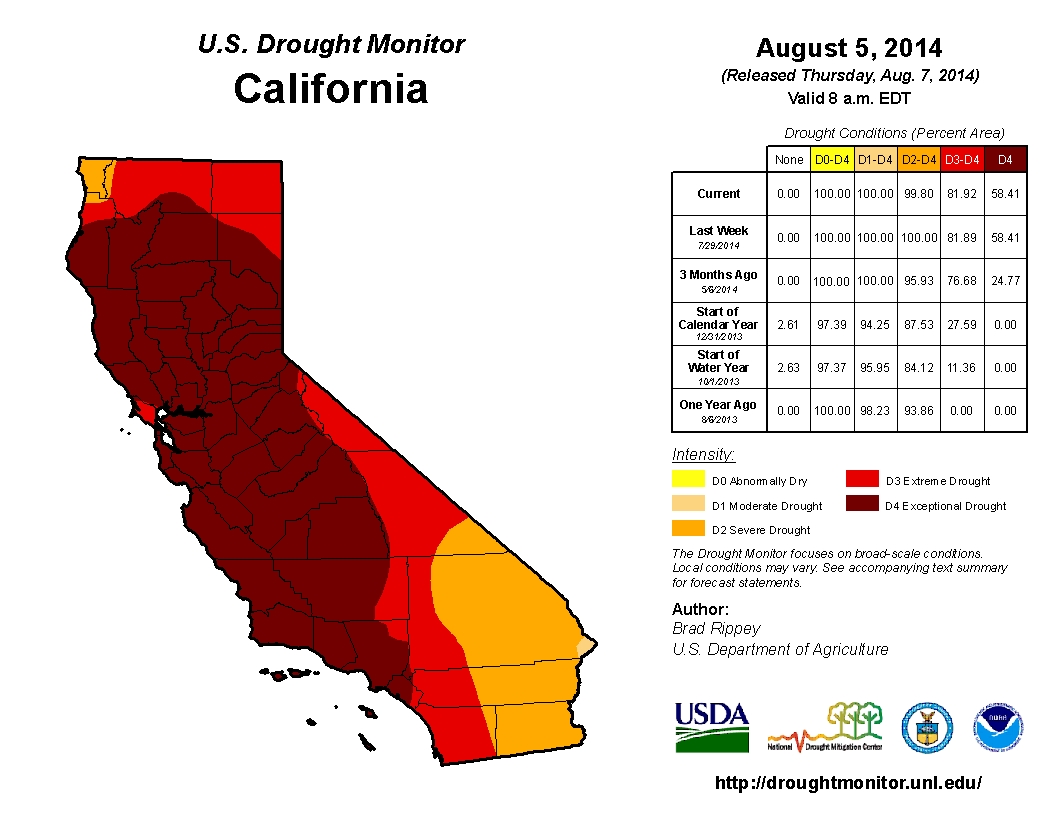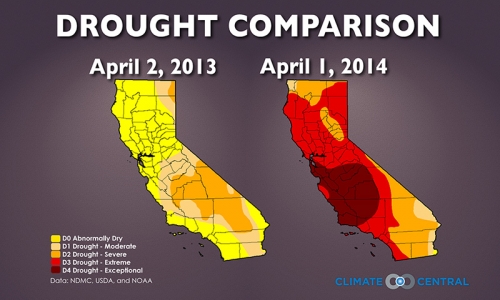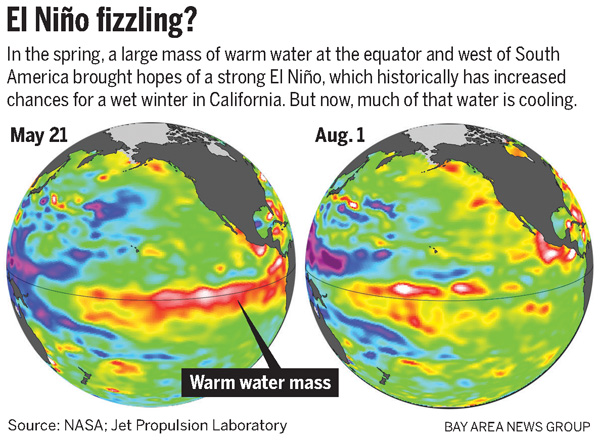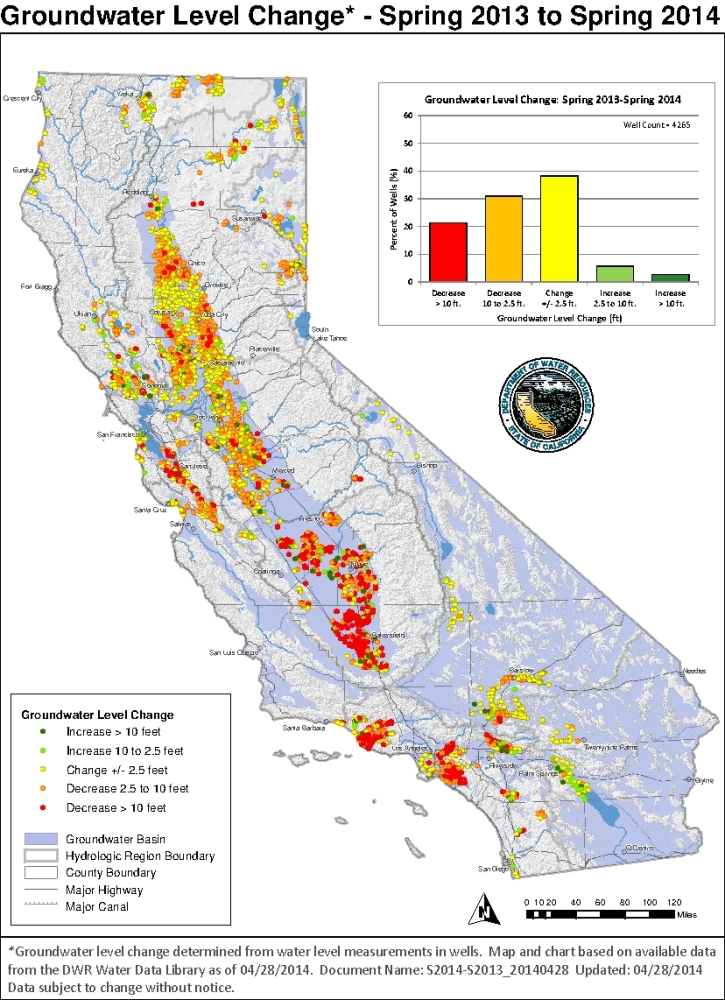“Between climate change, population growth, urbanization, chronic overuse of freshwater resources, and many other factors, we are heading towards one parched planet. In fact, the U.N. anticipates that 47 percent of the world’s population could be living under severe water stress by 2050. Agriculture is a big piece of the puzzle. Worldwide, over 90 percent of the water humans consume each day is attributable to food production – the numbers are mind-boggling. For example, a pound of corn needs about 108 gallons of water, a pound of cheese takes about 600 gallons of water, and a pound of beef clocks in a whopping 1,800 gallons of water to produce. In the United States, agriculture accounts for around 80 percent of the water we use each year” (source).
Here in California, 2013 was the driest year on record, and Governor Jerry Brown declared an official statewide drought on January 17, 2014 and appealed to Californians to voluntarily reduce water use by 20%. Initial lack of compliance with Brown’s appeal, multiple forest fires, dwindling water reserves, and fading hopes that an El Nino will develop are turning 2014 into another record drought year for the state.
As of early August, almost 60% of California is suffering “exceptional drought,” the most severe on the U.S. Drought Monitor’s five-point scale. About 82% of the state is in “extreme drought,” while 100% is now in “severe drought.” “State and local agencies are taking a broad suite of actions to combat drought and assist areas in greatest need. Local water agencies throughout California are calling for increased water conservation, with mandatory restrictions on water use and even rationing in place in some areas. As of Aug. 7, at least 93 local water agencies have implemented some form of mandatory restrictions / conservation, while at least 130 are calling for voluntary increased conservation in response to the drought and Gov. Jerry Brown’s call for all Californians to reduce water use” (source).
Parts of California did get some rain at the beginning of August, but the overall effect on the drought was inconsequential. “Reasons that California’s rain did not provide substantial drought relief included: 1) a lack of widespread coverage of the heaviest showers, 2) the fact that heavy showers mostly fell outside California’s key watershed areas in the Colorado River basin and the Sierra Nevada, and 3) the fact that the high runoff rate of the heaviest rain did not allow for significant percolation into drought-parched soils. Despite the cooler weather and showers, California’s rangeland condition remained steady (70% very poor to poor on August 3). Similarly, topsoil moisture (80% very short to short) and subsoil moisture (85% very short to short) were unchanged from the previous week. Across the northern tier of California, several wildfires—including the 30,000- to 40,000-acre Eiler and Bald fires—remained active in early August” (source).
“Agriculture consumes about 80 percent of all delivered water in the most-populous U.S. state. California’s 80,500 farms and ranches supply everything from milk, beef, and flowers to some of the nation’s largest fruit and vegetable crops, including almonds, avocados, and strawberries. The drought gripping the state that supplies half the fruits, vegetables, and nuts consumed in the U.S. has led federal and state providers to curtail the water they distribute to California’s farmers. That’s prompted districts representing growers to buy and sell for escalated prices from other parts of the state as thousands of acres go unplanted. The drought threatens to boost produce costs that are already elevated following a December frost, according to the U.S. Agriculture Department. The price of fresh fruit is forecast to rise as much as 6 percent this year, the department said last month. Dairy products, of which California is the biggest producer, may rise as much as 4 percent” (source).
Lack of surface water has forced farmers to rely more on groundwater. “In what would be the most significant water law passed in California in nearly 50 years, lawmakers in Sacramento are working with Gov. Jerry Brown on a landmark measure to regulate groundwater pumping for the first time. With an Aug. 31 deadline until the end of the session and billions of dollars at stake, negotiations among farmers, environmentalists, cities, and elected officials are reaching a crescendo. Although landowners who want to divert water from reservoirs and rivers have been required to get a permit from the state since 1914, farmers and cities who tap underground aquifers — California’s largest water source — can pump as much as they want, when they want, and with almost no oversight or limits. As a result, decades of intense pumping have dropped water tables dangerously low in places such as the San Joaquin Valley and Paso Robles. Scientific studies show the ground is sinking in many hard-hit areas and that aquifers are at risk of running dry” (source).
The other side of the coin, according to a UC Davis report, is that “the 2014 drought will result in a 6.6 million acre-foot reduction in surface water available to agriculture. This loss of surface water will be partially replaced by increasing groundwater pumping by 5 million acre-feet. The resulting net water shortage of 1.6 million acre-feet will cause losses of $810 million in crop revenue and $203 million in dairy and other livestock value, plus additional groundwater pumping costs of $454 million. These direct costs to agriculture total $1.5 billion. The total statewide economic cost of the 2014 drought is $2.2 billion, with a total loss of 17,100 seasonal and part-time jobs” (source).
The UC Davis report quoted above concludes that “California is surviving the drought this summer because it is using its water “bank account” — groundwater. The problem for the state is that nobody knows how big that bank account is because California is the only Western state that doesn’t measure its groundwater. About 5.5 million acre-feet of the 6.6 million acre-foot loss in surface water is made up for with groundwater pumping, which means that the state is really only feeling a water loss of about 1 million acre-feet, or enough to fill roughly 543,089 Olympic swimming pools.”
“But groundwater pumping comes at a cost to farmers — $454 million statewide — mainly because of the electricity required. It’s anybody’s guess how long that use of groundwater can go on for because the state doesn’t know how much groundwater is being used, preventing the state from managing its groundwater effectively, according to the report. The report calls on the state of California to more effectively manage groundwater and allow it to replenish in wet years. But when the next wet year will come is anybody’s guess, because there’s more than a 50 percent chance that the drought will drag on at least another year, Lund said” (source).






